Monday, March 28, 2005 |
2005 Angels Preview: Part 1, Rotation
Introduction
The 2004 Angels just squeaked by with a division win, their first in 18 years. Success, goes the saw, has many fathers, and paternity of the 2004 season rested upon- Arte Moreno spending a wad on quality free agents, in particular, Vladimir Guerrero and Kelvim Escobar.
- On-demand offense down the stretch, most notably by Vlad, whose last two weeks cemented his bid for an AL MVP award.
- Rotation and offensive collapses by Oakland down the stretch. Baseball Prospectus this year noted
Oakland's offense did about as well as expected, even with their decline, but the pitching was the real author of the team's September swoon:
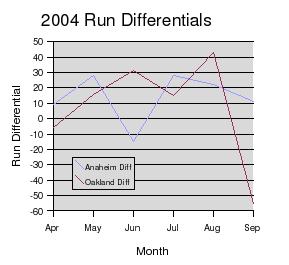
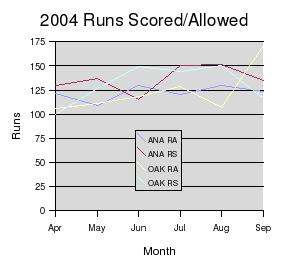
Oakland flat collapsed, and while their September nosed down some from August, it still outshone their April. No, the pitching was the obvious and main culprit, assisted at the last minute by a crucial blunder by then-Oakland bench coach Chris Speier.
To provide a different and sunnier view of the Angels' 2005 chances, I'm pleased as I can be to introduce Matt Welch. Matt is a columnist for Canada's National Post, and an associate editor at Reason. His fine Warblog has been a daily must-read of mine ever since I came across it late last year.
Matt: Hola! And thanks to Rob for having me. As for last year, the Angels would have waltzed to the playoffs had there not been major injuries to Glaus, Anderson, and El Gordo's first-half pitching mechanics. And obviously, Billy Beane's sh*t no longer works in the regular season.... One of my main reasons for optimism in 2005 is that the A's will almost certainly be weaker (unless the teenage pitching squad pulls a '69 Mets), and the Rangers and Mariners have too many glaring holes. The Angels, on the other hand -- and this will be my theme song -- are significantly deeper than they were a year ago, and will ride this depth to an easy division crown.
Rob: Thanks, Matt. After talking this over, we've decided to split this preview into multiple sections, one for each major part of the team, starting with the rotation, followed by infield, outfield, and the bullpen. Today, we'll start with the rotation.
Rotation
Rob: This isn't a crew you have high hopes for. There's nobody even remotely Randy Johnsonesque to be found in the
Matt: Au contraire! This is a group I have high
hopes for. Not Schilling-and-Unit high hopes, or even
Schilling-and-Pedro high hopes, but the kind of
4th-starter-will-have-an-ERA+-of-111 high hopes that seemed to work
out just fine in 2002.
The main sources of recent SP ugliness -- Ortiz and Sele -- have been replaced by a quality innings-muncher (for a fraction of the cost), and there is good reason to expect improvements from most of the other starters as well, especially in light of a sure-to-be-better defense.
Paul Byrd
|
|
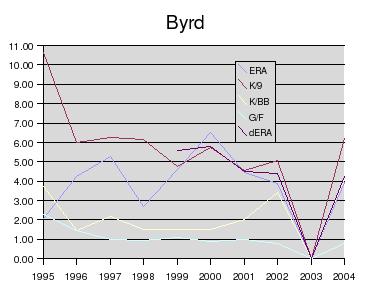 | 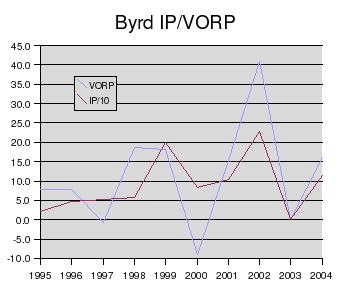 |
PECOTA: VORP: 14.6, ERA: 4.87, IP: 137.2, Similarity: 34
Rob: I've already laid out the case for Byrd's ascent to something other than a tail-end-innings-eater based on the miles between him and a Tommy John surgery, improved velocity, a new sinkerball he couldn't previously throw, and increasing K/9 and K/BB rates. The 34 year old Byrd's not a guy you want to build a rotation around, but he represents the kind of roulette spin Bill Stoneman's made with castoffs (viz. David Eckstein, Ben Weber, etc.) in his shrewder moments. I'm going to suggest PECOTA's similarity score and his recovery from surgery means his projection's a little too conservative, and he'll be worth about two wins, ending the year with a 4.30 ERA or so.
Matt: I'm bullish on Byrd, too, but with one ulcer-inducing caveat -- the Mazzone effect. Since 1991, by my reckoning, 16 pitchers have left the womb of Leo Mazzone's starting rotation (and Andrew Jones' CF play) to pitch for another team the following year. Eleven of the 12 had their ERA+s plummet -- by an average of 30 points, which is pretty impressive considering the league average is 100 -- and the 12th retired after pitching two more innings (all but two saw their IPs drop, usually sharply). Of the four remaining, two performed at essentially the same level (Maddux and Mulholland), and only two of the whole damned lot of 16 showed any improvement at all -- a 24-year-old Jason Schmidt, and 25-year-old Odalis Perez. He's a great pickup, and a terrific upgrade on Ortiz/Sele, but my fingers are crossed.
Rob: Good point about Byrd and outfield defense; in the last couple years his G/F has been under unity by a sizeable amount. Now, some of that may be that he couldn't throw the sinker, in which case we can expect something closer to one, but that just shifts the concerns to the infield defense, about which, more later.
I asked Tom Meagher of The Fourth
Outfielder about collecting the raw data needed to regress
Byrd from Turner Field back to Angels Stadium, similar to what he
did for
Derek
Lowe and Dodger Stadium. He couldn't get me the data directly,
but did suggest that Byrd would be hurt by Angels Stadium's smaller
foul territory, but helped significantly by the Angels' home park's
tendency to give up few doubles and home runs.
Colón
| Year | IP | ERA | K/9 | K/BB | G/F | dERA | VORP |
|---|---|---|---|---|---|---|---|
| 1998 | 204.0 | 3.71 | 6.97 | 2.00 | 1.52 | N/A | 51.2 |
| 1999 | 205.0 | 3.95 | 7.07 | 2.12 | 1.52 | N/A | 53.8 |
| 2000 | 188.0 | 3.88 | 10.15 | 2.16 | 1.13 | 3.78 | 53.0 |
| 2001 | 222.1 | 4.09 | 8.14 | 2.23 | 1.15 | 3.93 | 43.7 |
| 2002 | 233.1 | 2.93 | 5.75 | 2.13 | 1.37 | 3.90 | 40.3 |
| 2003 | 242.0 | 3.87 | 6.43 | 2.58 | 0.92 | 4.05 | 56.9 |
| 2004 | 208.1 | 5.01 | 6.83 | 2.23 | 0.91 | 5.03 | 22.2 |
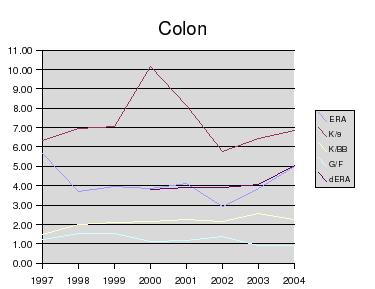 | 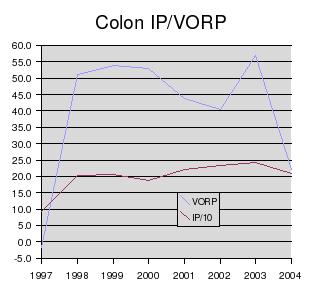 |
PECOTA: VORP: 14.6, ERA: 4.87, IP: 137.2, Similarity: 34
Rob: 2005 resolution: I will not make any stupid puns about the large Colon, er, colon. Now that that lie's out of the way, Bartolo's forgettable 2004 supposedly hinged on ankle problems, from which he recovered in July, but he only posted one sub-4.00 ERA month (July) all last year. Nobody's going to mistake him for core training obsessor Steve Finley; last year, Colon showed up to spring training overweight, and this year he dodged the lipo-police in the Dominican. There's plenty of reason for concern about Colon's ability to both stay healthy and pitch well. PECOTA thinks he peaked early, and I'm inclined to agree.
Matt: I expect Bart to revert to his second-half self last year (104 IP, 3.63 ERA, 82 Ks), which is exactly in line with his career numbers. He's pitched 200+ innings six out of seven years, with an ERA+ of at least 111 every but last, and his career year was as recent as 2002. That said, I have the impression that he makes pitching adjustments slower even then he walks on and off the field, which means entire two-month stretches where he's just crap, nibbling himself into hitter's counts, grooving 92-mph fastballs, and yielding fantastic numbers of homers. Last first half was indeed historically pukey, but check out the first halves of 1999 and 2000, and the second half of '98. Hopefully, Black knows how to talk to him now.
Escobar
| Year | IP | ERA | K/9 | K/BB | G/F | dERA | VORP |
|---|---|---|---|---|---|---|---|
| 1997 | 31.0 | 2.90 | 10.45 | 1.90 | 1.81 | N/A | 9.3 |
| 1998 | 79.2 | 3.73 | 8.13 | 2.06 | 0.94 | N/A | 18.6 |
| 1999 | 174.0 | 5.69 | 6.67 | 1.59 | 1.11 | N/A | 10.1 |
| 2000 | 180.0 | 5.35 | 7.1 | 1.67 | 1.04 | 4.66 | 15.6 |
| 2001 | 126.0 | 3.50 | 8.64 | 2.33 | 1.36 | 3.34 | 33.9 |
| 2002 | 78.0 | 4.27 | 9.81 | 1.93 | 1.03 | 4.08 | 12.8 |
| 2003 | 180.1 | 4.29 | 7.94 | 2.04 | 1.54 | 3.89 | 28.2 |
| 2004 | 208.1 | 3.93 | 8.25 | 2.51 | 1.14 | 3.87 | 53.2 |
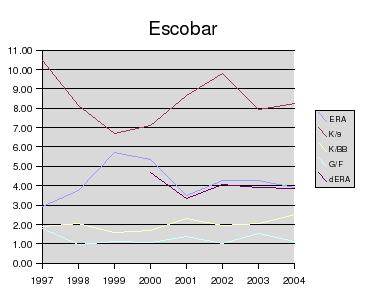 | 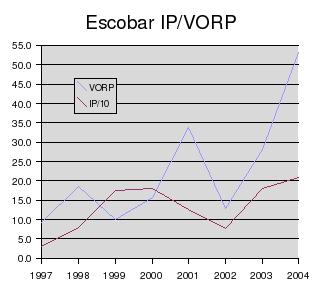 |
PECOTA: VORP: 30.8, ERA: 4.12, IP: 168.0, Similarity: 55
Rob: Another of Stoneman's shrewd signings, I liked Escobar going into last year principally because of his splits on grass; away from the turf, Esky was a pretty accomplished pitcher. Amazingly, he managed to keep that up; his ERA on grass this year was a very respectable 3.81, while his small-sample-sized turf ERA of 6.30 (10 IP) is consistent with his inconsistent old Toronto self. PECOTA's overly pessimistic on him in part because of managerial decisions by the Jays, who could never decide whether he belonged in the rotation or the bullpen. With comparables including Andy Messersmith, Chan Ho Park, Bartolo Colon, and John Smoltz, Escobar's direction could be anywhere, but I'm betting his decline is overstated, and his 60th percentile projection (3.76 ERA, 180.2 IP, 41.0 VORP) is likely.
Matt: All four of his pitches rank among the league's best;
he's indeed off the grass and away from idiot Blue Jay management;
last year he struck out 8.25 per 9 as a starter, and this year he'll
probably enjoy luckier run support. I predict he'll make the All-Star
team, and solidify his role as ace.
Lackey
| Year | IP | ERA | K/9 | K/BB | G/F | dERA | VORP |
|---|---|---|---|---|---|---|---|
| 2002 | 108.1 | 3.66 | 5.73 | 2.09 | 1.31 | 4.24 | 20.0 |
| 2003 | 204.0 | 4.63 | 6.66 | 2.29 | 1.07 | 4.80 | 21.2 |
| 2004 | 198.1 | 4.67 | 6.53 | 2.40 | 1.11 | 4.16 | 29.3 |
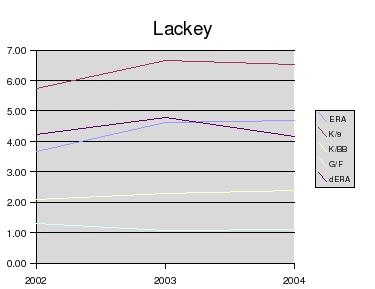 | 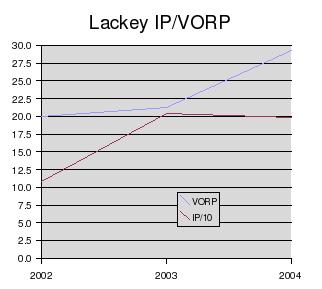 |
PECOTA: VORP: 16.4, ERA: 4.77, IP: 155.0, Similarity: 63
Rob: Lackey's still cheap, which is why he remains in the rotation, but his is a story of unfulfilled promise, not unlike the next guy on this list, Jarrod Washburn. Baseball Prospectus is somewhat optimistic about his chances this year, noting the disparity between his home (3.48) and away (5.72) ERAs, and that he didn't give up a single home run in September. On the other hand, he only gave up three in August and September of his rookie 2002 campaign, so that doesn't necessarily mean anything. Unless something happens this year and Lackey figures out how to reliably make that third out, he'll find himself in Pirates spring training camp fighting for a relief job in three years or so.
Matt: Look at his IP/K/BB numbers from the last two years: 204/151/66, 198/144/60 (and those numbers from last year also include 87 Ks in 90 IP after the All-Star break). That's pretty damned good for a guy at ages 24-25. Especially considering that, at least according to David Pinto, Lackey had the seventh-worst defensive support of any AL starter last year. Given his youth, size, health, peripherals, and better D, I think he's the best bet on staff to improve by 10-20% this year.
Rob: Pinto's not the only one who thinks Lackey got
screwed. Studes says he was just
plain unlucky with line drives in 2004, along with
Scot
Shields, and is due for a bounceback season as his luck
normalizes. So maybe I'm being a little harsh on Lack.
Washburn
| Year | IP | ERA | K/9 | K/BB | G/F | dERA | VORP |
|---|---|---|---|---|---|---|---|
| 1998 | 74.0 | 4.62 | 5.84 | 1.78 | 0.65 | N/A | 11.6 |
| 1999 | 61.2 | 5.25 | 5.69 | 1.50 | 0.90 | N/A | 9.5 |
| 2000 | 84.1 | 3.74 | 5.23 | 1.32 | 0.62 | 5.72 | 24.4 |
| 2001 | 193.1 | 3.77 | 5.87 | 2.33 | 0.65 | 4.29 | 41.1 |
| 2002 | 206.0 | 3.15 | 6.07 | 2.36 | 0.60 | 4.10 | 61.9 |
| 2003 | 207.1 | 4.43 | 5.12 | 2.19 | 0.68 | 5.24 | 34.4 |
| 2004 | 149.1 | 4.64 | 5.18 | 2.15 | 0.96 | 4.70 | 22.4 |
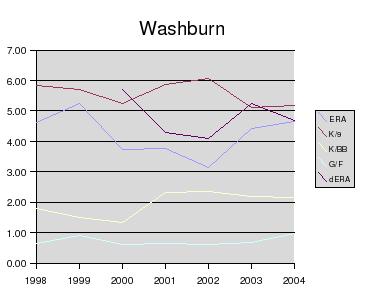 |  |
PECOTA: VORP: 18.1, ERA: 4.56, IP: 136.1, Similarity: 56
Rob: The older, left-handed isomer of John Lackey, with less upside. Washburn served his purpose in 2002 and has declined ever since, though one interesting development from 2004 was the sudden increase in ground balls, a good thing considering how bad the Angels' outfield defense was last year. A Scott Boras client, he's certain to get too much money for the mound space he occupies after this season. Whether the Angels retain his "services" beyond 2005 will be a function of how terrible the free agency market is, and whether Ervin "The Other" Santana is ready for everyday use.
Matt: He's healthy (unlike last year), has a better defense to catch all those balls in play, is in his walk-year, and he knows the Angels probably won't bring him back. Even when hurt & crappy he was around league-average last year; I'd peg a motivated and healthy Wash for something like 14-12, 200 IP, and an ERA around 4.30. Nothing earth-shaking, but perhaps the best 5th starter in the league.
Depth: The Sixth Starter
Rob: When you say, "depth", you're talking about swingman Scot Shields, or relative newcomer, Kevin Gregg. Let's take a quick look at both their numbers, shall we?
|
|
||||||||||||||||||||||||||||||||||||||||||||||||||||||||||||||||||||||||||||||||||
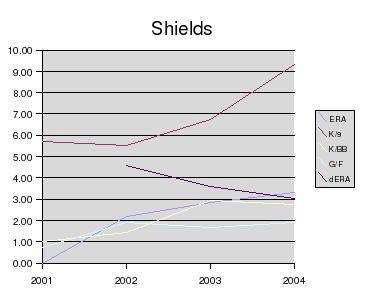 | 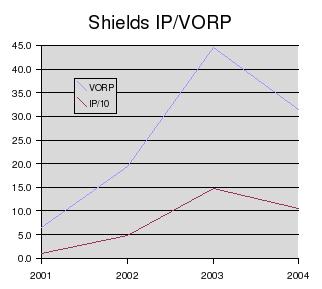 |
PECOTA:
Gregg: VORP: 14.3, ERA: 4.38, IP: 92.1, Similarity: 45(Sorry, no graphs for Gregg; once he gets three years in the majors, maybe then.)
Shields: VORP: 22.2, ERA: 3.73, IP: 99.0, Similarity: 53
Rob: For a while last year, I thought sure Kevin Gregg would force his way into the rotation. Up through early June, he was arguably the best pitcher on the staff, ringing up an otherworldly 0.59 ERA in April and a still-pretty-damn-good 2.12 ERA in May, but he quickly fell back to earth, only notching one more month (July, 3.72) below 5.00 the rest of the way. As a result, Gregg has a lot to prove this year: first, that his 2004 April and May weren't a fluke; second, that he has some control. His 13 wild pitches placed second in the AL; only Yankee/Chisox starter Jose Contreras was worse (at 17). In a July 25th game at Seattle, he set an American League record for most wild pitches in a single inning. The boy's got some learnin' to do.
Like Shields, Gregg can handle starting. Coming up through Oakland's system at the same time as their former Big Three, Gregg trained as a starter. (Note: the Baseball Cube numbers appear to be wrong, in that they have him coming up through the Angels' system in the mid-90's.) Ultimately, Oakland released him, and he signed with the Angels in 2003. As the season wore on and his WHIP grew like Topsy, the Angels pushed him into mop-up duties. With only three pitches, he's not a complete package, but used somewhat more judiciously, and/or with improved stamina, he has a reasonable chance at improving on his 2004, and might even land a spot start or two.
Scot Shields attracts the phrase "rubber-armed", and no wonder: despite his workload dropping a third from 2003, he still threw more innings in relief in 2004 (105.1) than any other pitcher in the majors. One result: a rising strikeout rate, up almost three full points. Despite April and September struggles, Shields posted three months of 3.00 or below ERAs. With slightly better numbers against lefties than righties, he's one of the big reasons Scioscia has had the luxury of a LOOGYless pen the past two years.
In 2003, Shields started in thirteen games, not so much because the Angels liked him in that role, but because of injuries. Sporting a 4-6 record in 13 starts, Shields' early season starts were strong but they got rougher as the season went on. The Angels did not start him at all in 2004, perhaps due to his lack of a true "out" pitch. Moral: don't expect to see Shields start unless something goes truly, awfully wrong.
Conclusions, Anyone?
Rob: In isolation, this staff doesn't impress. Here's overall rank by ERA among AL starters who qualified for the ERA title in 2004:
| Starter | ERA | Rank |
|---|---|---|
| Escobar | 3.93 | 9th |
| Lackey | 4.67 | 20th |
| Colon | 5.01 | 31st |
In other words, a middling bunch. Adding VORP scores of the likely starters, I come up with 131.4 -- versus last year's actual of 140.5. I just don't see them being an improvement over last year's squad. Obviously, with improved health and slightly better defense behind them, this could change, but with Escobar possibly starting the season on the DL, and Colon already leaving a spring training game due to back spasms, it's hard to argue they'll get those kinds of breaks.
Matt: Good thing seasons aren't played "in isolation"!
Let's look at the four AL West starting rotations last year, ranked in order of ERA (unadjusted for park):
| Team | IP | R | ER | ERA | Lg. rank |
|---|---|---|---|---|---|
| A's | 1030.6 | 529 | 486 | 4.24 | #2 |
| Angels | 964 | 529 | 503 | 4.70 | #4 |
| Mariners | 988.3 | 571 | 536 | 4.88 | #8 |
| Rangers | 901 | 557 | 515 | 5.16 | #11 |
The A's lost Mulder and Hudson and Redmond, the Mariners Freddy Garcia, and the Angels ... Sele and Ortiz, who combined for a 5.20 ERA in 38 starts across just 200 innings. I believe the Angels rotation will easily be better than Oakland's this year, by the mere fact of replacing Ortiz/Sele with Paul Byrd, and the A's losing Tim Hudson.
What's a reasonable projection for Byrd? In 2002, he had a 3.90 ERA in 228.1 innings for Kansas City; in 2004 it was 3.94 and 114.1 on a sore arm for Leo Mazzone. So, let's imagine he's good for a 3.96 in 200 innings. Further, let's imagine that the rest of the Angels' rotation is exactly as bad as last year, and the starts missed by an injured Washburn will only be 5-inning, 4.50 ERA jobs from Gregg/Shields. How does that affect the rotation? (And, for the sake of argument, let's assume Byrd will have a 4.37 ERA as well.)
| Year | IP | R | ER | ERA |
|---|---|---|---|---|
| 2004 | 964 | 529 | 503 | 4.70 |
| 2005 | 993.3 | 513 | 490 | 4.44 |
Now let's replace Tim Hudson, generously, with a pitcher who takes his 27 starts, and fills them up with number that match the rest of Oakland's 2004 starters in IP per start, runs, and ERA:
| Year | IP | R | ER | ERA |
|---|---|---|---|---|
| 2004 | 1030.7 | 529 | 486 | 4.24 |
| 2005 | 1007.7 | 538 | 494 | 4.41 |
Even if Byrd pulls a 4.37 ERA, the Angels have still narrowed the starters' ERA gap from 0.56 or a run to 0.13, and (more crucially?) cut down the IP gap from 66 to 14, giving us better opportunity to deploy our vastly superior bullpen. And that's assuming the best for Oakland, and the status quo for the Angels. I think Colon and Lackey will actually perform better than last year; even if we keep Escobar and Washburn the same, and assume a 4.37 ERA for Byrd, this is how the rotation would shake out:
| Name | IP | R | ER | ERA | GS |
|---|---|---|---|---|---|
| Colon | 208.3 | 110 | 104 | 4.49 | 33 |
| Escobar | 208.3 | 91 | 91 | 3.93 | 33 |
| Lackey | 205.7 | 107 | 100 | 4.37 | 33 |
| Washburn | 149.3 | 81 | 77 | 4.64 | 25 |
| Byrd | 200 | 105 | 97 | 4.37 | 33 |
| #6 | 25 | 14 | 13 | 4.68 | 5 |
| Totals | 996.7 | 508 | 482 | 4.35 | 162 |
That would be 21 runs fewer than last year, in 30 more innings, and would compete for the second-best starters' ERA in the league (behind Minnesota), while giving the league's best bullpen more breathing room. I think there's a 50-50 chance that these results will be even better. The rotation is a marked improvement, and a strength. My worry is only that it won't be dominant enough in the post-season.
Rob: Wow, Matt, no compensation for the fact that Escobar had a career year last year? Whatever, I think that about wraps it up for now. Coming up next: the infield.
We haven't gotten to the pen yet, but as I said at Hardball Times, there's a real possibility the pen has been taken too lightly this year, and the Angels will pay for it. The scuffle at the end of spring training for the last bullpen spots are a telling tale.
Disagreed with you on Finley, obviously; I think it could turn out to be one of the best offseason signings anybody made. Fins might decline, but it's a good bet that he won't do so enough to make the team horrible, and in any case, he's better than an arthritic Anderson in center. Cabrera is another story, and no question but that Stoneman made a mistake.
No question but that there's no clear favorite in the division. The fact that Beane has taken the Angels' pitching construction to heart -- namely, build a cheap, lights-out bullpen and worry about the starters afterwards -- is in some ways a validation of their philosophy. Too bad the Angels seem to have abandoned it, or at least, let it slide now.
Newer› ‹Older


Post a Comment
Note: Only a member of this blog may post a comment.